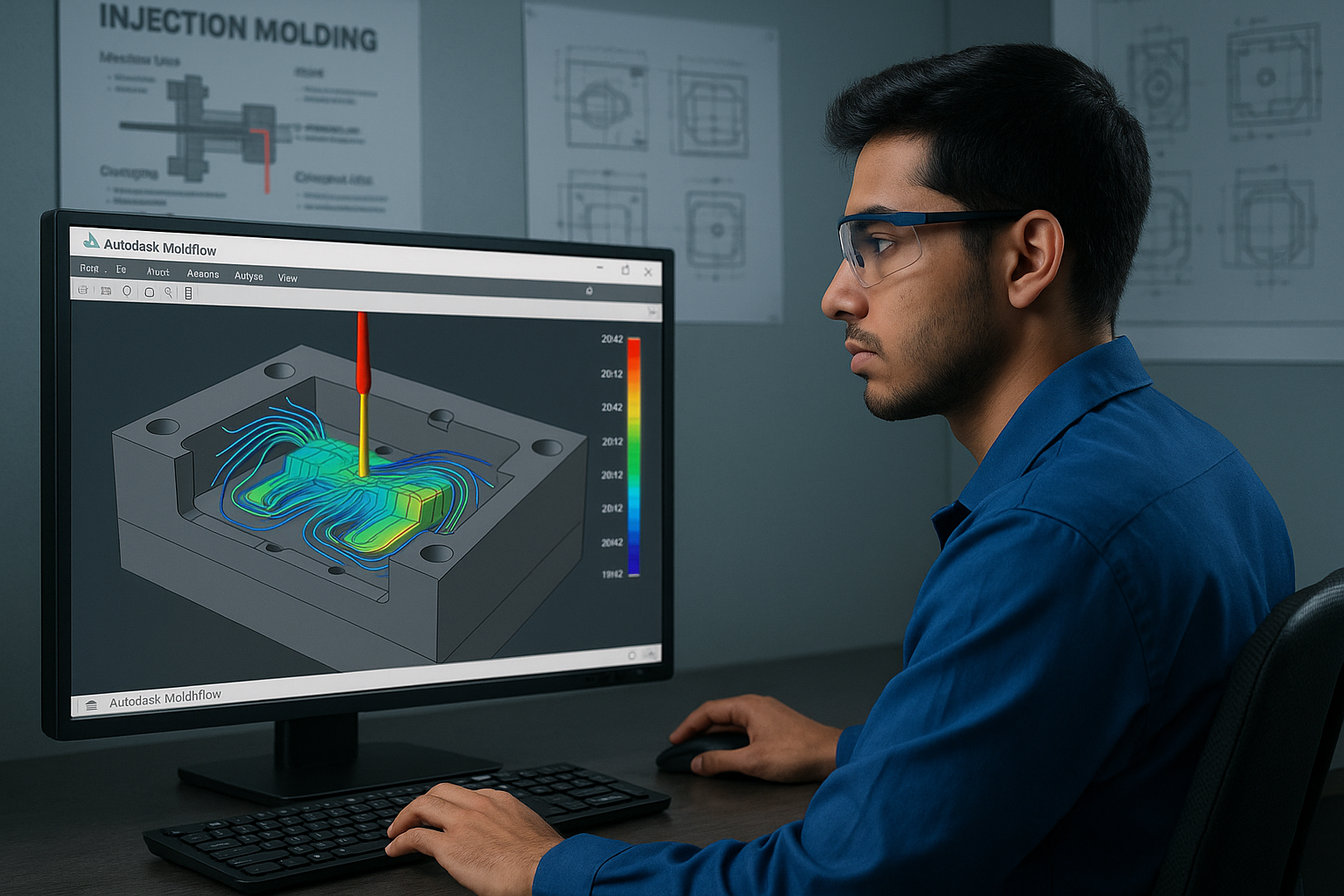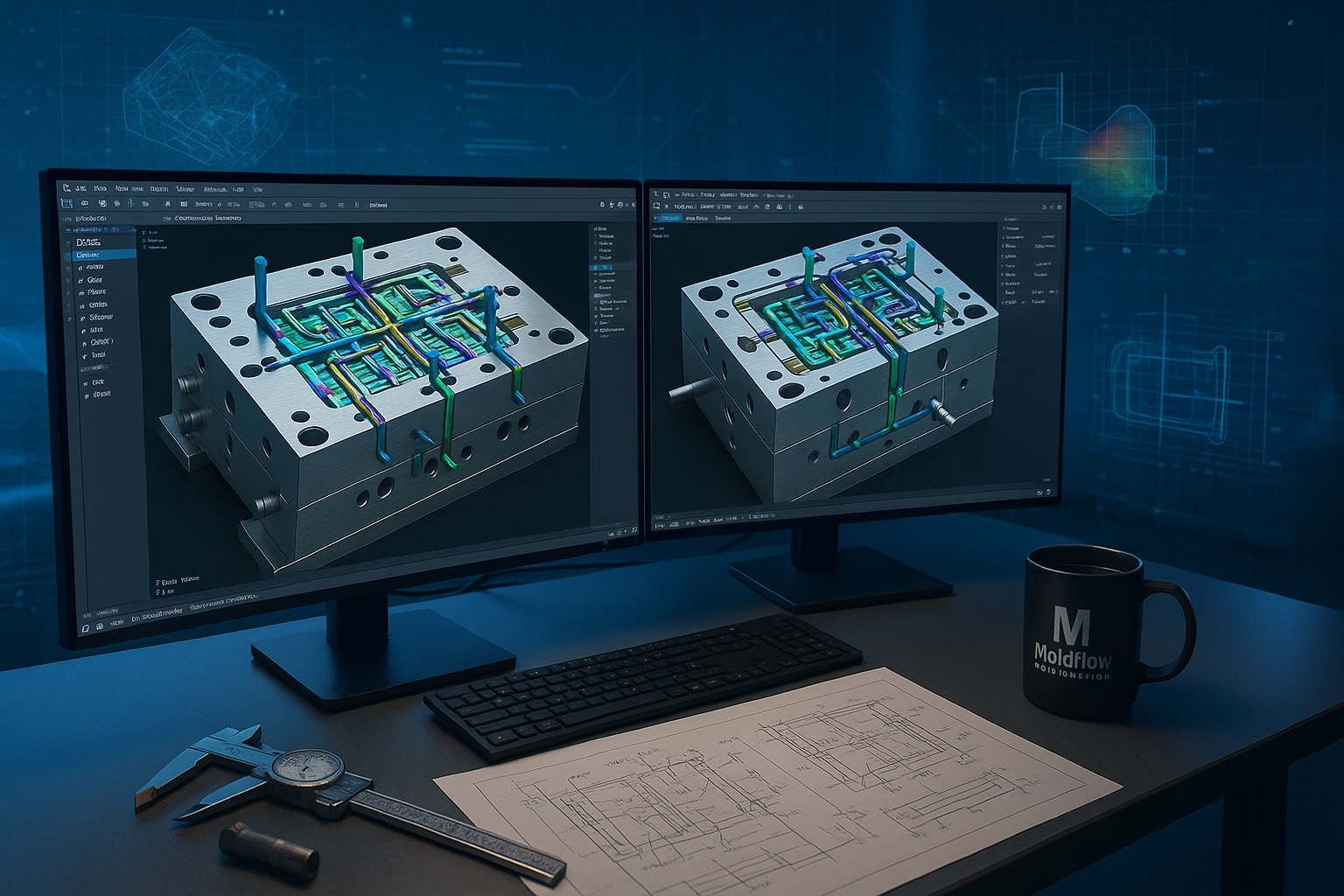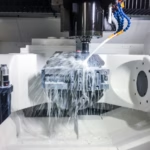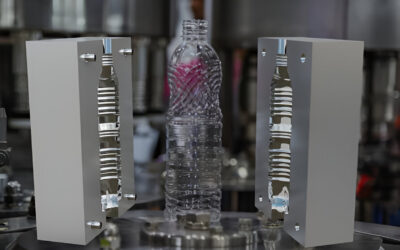In the world of plastic injection molding, it’s all about accuracy, efficiency, and quality. No manufacturer wants to come across defects, warpage issues, or must for rework after the molded part has been casted. And that’s why Mold Flow Analysis becomes such a significant step in Injection Mold design.
With the help of exclusive injection mold design software like Autodesk Moldflow designers get to understand how exactly does the plastic flow happening, if any problem could happen so as to highlight them in advance and make some changes in designs. Which ultimately saves time and cost plus assures perfect quality assured manufacturing of Plastic Parts with utmost precision.
Understanding Mold Flow Analysis
Definition and Purpose
Mold Flow Analysis is a simulation technique used to analyze the flow of molten plastic inside an injection mold. It predicts the injection filling pattern, potential air traps or weld lines in the part and also analyzes how cooling influences part quality.
The main purpose of this analysis is to optimize the injection mold design and enhance the performance of injection molding process before actually manufacturing the mold.
How Mold Flow Analysis Works?
The process of Mold Flow Analysis involves simulating how molten plastic moves, cools, and solidifies inside a mold cavity before actual production. It allows engineers and designers to understand how the material behaves under real molding conditions — without wasting time, material, or machine hours.
1. Creating the 3D Model
The first step is to create a high-quality 3D CAD model of the part and mold assembly. This model contains all important design features such as gates, runners, sprues, vents and cooling channels. The model then is imported into Autodesk Moldflow (any other injection mold design software) for simulation.
2. Generate mesh
Once the 3D model is complete it is divided into many thousands, or even millions, of tiny elements in a process known as meshing. It is these mesh elements that form the computational grid which the software will use to calculate how the molten plastic will behave as it flows and cools.
3. Material telling
After meshing, the next step involves selecting plastic material from available in-built software database. Autodesk Moldflow or any other injection molding software comes with huge material library having details like melt flow index, viscosity, density and shrinkage etc.
4. Defining Boundary Conditions
This stage involves configuration of process parameters such as:
- Melt temperature
- Mold temperature
- Injection pressure
- Injection speed
- Packing and cooling time
- Gate location and size
- The last step is to run the simulation
5. Running the Simulation
Once all of the parameters have been defined, the moldflow simulation is started and the injection mold design software virtually injects molten plastic into the cavity and shows how it travels through the sprue, runner and gate system.
The analysis includes a number of phases:
a. Filling Analysis
This step helps to visualize how the molten plastic flows and enters mold cavity. It shows if there’s any short shot happens, where the flow is restricted and where air traps or weld lines are likely to be formed. It can also calculate flow front temperature, pressure, and velocity.
b. Packing Analysis
Once the cavity is filled, packing pressure is applied to pack the part because of material shrinkage. Mold Flow Analysis will provide the best packing time and pressure to prevent any voids and sink marks.



Common Problems Solved by Mold Flow Analysis
In the plastic injection molding industry, any small defect can mean big losses in terms of time, money and material. When molten plastic is injected into the mold, its behavior depends on parameters like pressure, temperature, gate design and cooling rate. If you cannot predict these accurately, some common defects such as short shots (not filling completely), weld lines (caused by flow fronts meeting), warpage or voids are almost guaranteed to occur.
This is why Mold Flow Analysis — backed by cutting edge software like Autodesk Moldflow from Moldflow Corporation — has become an absolutely indispensable part of injection mold design and plastic mold making. By running advanced injection molding analysis simulations on CAD data of a part or tool engineers can predict visible pitfalls & problems before actual product development.
1. Short Shots
With the mold flow simulation in injection mold design software, plastic flow is visualized. The software will find pressure drop areas and predict where filling may stop. Users can move gate location, increase injection speed or optimize wall thickness to get complete cavity fill and smoother molding.
2. Air traps and gas pockets
In industrial injection molding, it’s important to manage air traps to keep surfaces clean and make high quality and durable parts. This knowledge enables mold designers improve venting systems before making a plastic mold make.
3. Weld Lines and Knit Lines
With Mold Flow Analysis we can see exactly where those weld lines will occur and with our software for injection molding analysis changes our engineers recommend for gate placement, flow direction or speed they can be modified hence making sure it doesn’t cross through critical sections. This is important considering when weld lines form at a point in your part where it sees tremendous stress during its service life they become weak spots!
4. Warpage and Shrinkage
Both warpage and shrinkage can be predicted with the help of moldflow simulation, this can be done by performing both cooling analysis as well as warping analysis. Designers will be able to optimize the cooling channel design, packing pressure, and mold temperature using Autodesk Moldflow. This ensures good dimensional stability, especially for automotive and medical parts, where assembly accuracy is crucial.
Conclusion
In the world of plastic injection molding, precision and consistency are paramount. A small mistake in mold creation or a simple miscalculation in material behavior can lead to flawed parts and serious setbacks in production schedules. That is why Mold Flow Analysis has become so important in today’s plastic molding industry. It helps engineers spot potential cosmetic issues, like warping or sinks. It also identifies structural flaws before any material is injected, using accurate computer simulations.
But this is not just a design tool. It is a methodology that takes you from an idea all the way to production. Whether it is micro molding for high-precision parts or automotive and medical-grade components, moldflow simulation ensures optimal product performance. It minimizes risk and reduces cost. This makes Mold Flow Analysis essential for anyone in plastic parts manufacturing. It is also crucial for injection mold building.








0 Comments